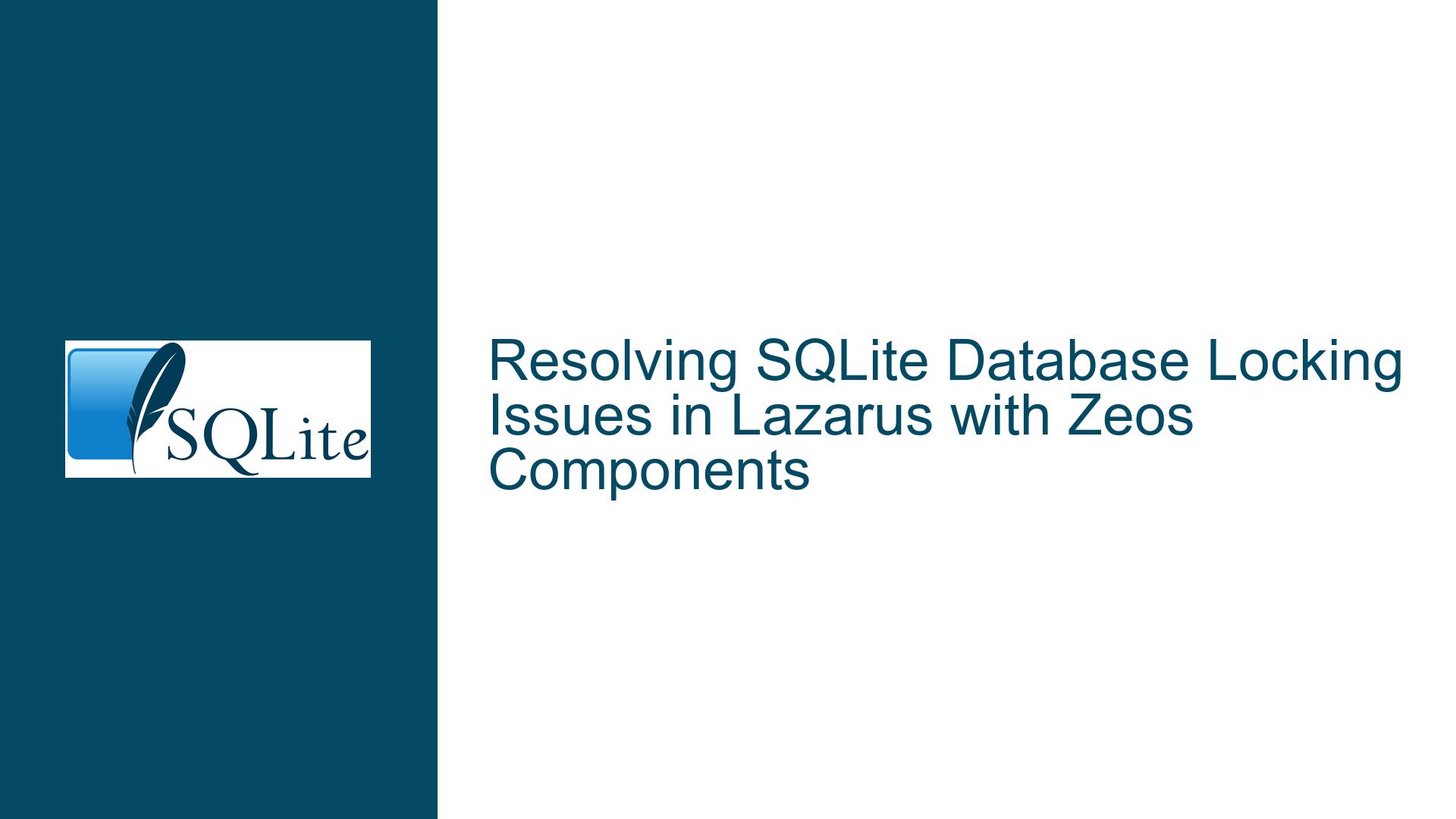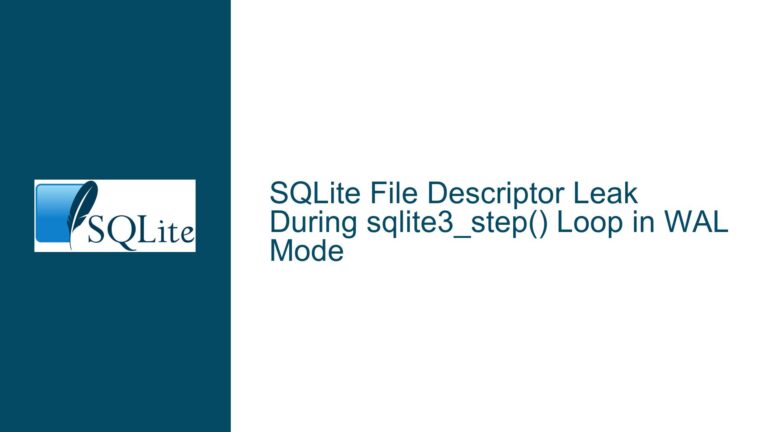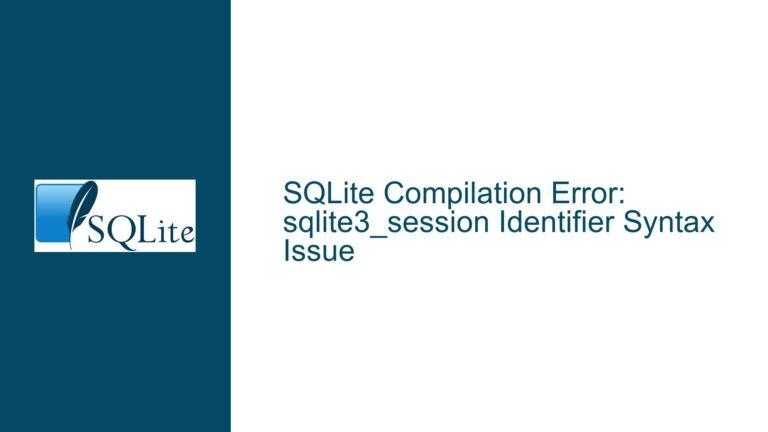Resolving SQLite Database Locking Issues in Lazarus with Zeos Components
Issue Overview: Database Locking During Sequential Transactions in Lazarus
The core issue revolves around encountering a "Database Locked" error when performing sequential database operations (specifically, a SELECT followed by an INSERT) in a Lazarus application using the Zeos library with SQLite. The error occurs despite the absence of multithreading, network storage (NAS), or concurrent processes. The problem is isolated to the second table (T2), while operations on the first table (T1) work without issues. Key observations include:
- Transactional Boundaries: The code explicitly starts and commits transactions around both the
SELECTandINSERToperations. - Query Closure: Queries are closed after execution, which should release associated locks.
- IDE Configuration: The TZConnection component is left open in the Lazarus IDE designer, potentially holding a persistent connection.
- Zeos Library Behavior: The library’s internal handling of transactions and locks might differ from SQLite’s native behavior, leading to unexpected locking.
The resolution involved adding an explicit Commit after closing the query, suggesting that implicit transaction management by Zeos was insufficient in this scenario. The error message ("Database Locked") is inconsistent with SQLite’s native "Database Busy" error, implying that Zeos or the Lazarus IDE might be introducing additional locking mechanisms.
Possible Causes: Transaction Management, Component State, and Journal Mode
1. Implicit Transaction Retention by Zeos
- Uncommitted Read Transactions: Even after closing a query, Zeos might retain a read transaction if not explicitly committed. SQLite’s read transactions acquire a
SHAREDlock, which blocks writers until released. - Auto-Commit Discrepancies: Zeos may default to manual transaction control, requiring explicit
Commitcalls even for read operations. Unlike SQLite’s default auto-commit mode, where each statement is a transaction, Zeos might bundle operations into larger transactions.
2. IDE-Designer Connection Leaks
- Persistent TZConnection in Designer: Leaving
TZConnection.Active := Truein the Lazarus IDE designer can create a persistent connection to the database. This connection may hold aSHAREDlock indefinitely, blocking writes from the runtime application. - Design-Time Queries: Metadata queries executed by the IDE (e.g., to populate table/column lists) might not release locks promptly, especially if
DesignConnectionis misconfigured.
3. SQLite Journal Mode and Locking Semantics
- Rollback Journal (DELETE Mode): In the default journal mode, SQLite uses a
RESERVEDlock during writes, which blocks other writers but allows readers. However, if a read transaction is still active (due to uncommitted transactions), theRESERVEDlock cannot upgrade to anEXCLUSIVElock, causing "Database Busy" errors. - WAL Mode Differences: If the database uses Write-Ahead Logging (WAL), concurrent reads and writes are allowed, but Zeos might not fully support WAL’s locking semantics.
4. Component Lifecycle and Resource Leaks
- Unclosed Dataset Handles: While the code explicitly closes
ZQ_getmax, other components (e.g.,ZQ_insert_img) might retain prepared statements or cursors, keeping the database locked. - Transaction Isolation Levels: Zeos’ default isolation level (
tiNone) might conflict with SQLite’s locking model, especially when nested transactions are involved.
Troubleshooting Steps, Solutions & Fixes
Step 1: Validate Transaction Boundaries and Commit Semantics
Explicit Commit After Reads:
- Problem: The
SELECTquery acquires aSHAREDlock. If Zeos does not auto-commit read transactions, the lock persists until the connection is closed or the transaction is committed. - Solution:
datamod.dmHuffin.ZConnection1.StartTransaction; try datamod.dmHuffin.ZQ_getmax.Open; // ... process results ... finally datamod.dmHuffin.ZQ_getmax.Close; datamod.dmHuffin.ZConnection1.Commit; end; - Rationale: Ensures the read transaction is committed immediately, releasing the
SHAREDlock.
- Problem: The
Avoid Implicit Transactions:
- Problem: Zeos might implicitly start transactions for operations that do not require them.
- Solution: Set
ZConnection1.AutoCommit := Truefor read-only operations or single-statement writes.
Step 2: Diagnose and Mitigate IDE-Related Locking
Disable Design-Time Connections:
- Problem: The IDE’s design-time connection holds a
SHAREDlock. - Solution:
- Set
TZConnection.DesignConnection := False. - Set
TZConnection.Active := Falseat design time.
- Set
- Verification: Close and reopen the Lazarus IDE to ensure no lingering connections.
- Problem: The IDE’s design-time connection holds a
Separate Design-Time and Runtime Connections:
- Problem: Metadata queries (e.g., fetching table schemas) might lock the database.
- Solution: Use a separate SQLite database file for design-time exploration.
Step 3: Configure SQLite Journal Mode and Locking Parameters
Switch to WAL Mode:
- Problem: The default rollback journal mode (
DELETE) creates writer-blocking scenarios. - Solution:
PRAGMA journal_mode = WAL; - Effect: Allows concurrent reads and writes, reducing contention.
- Problem: The default rollback journal mode (
Set Busy Timeout:
- Problem: SQLite immediately returns "Database Busy" instead of retrying.
- Solution:
datamod.dmHuffin.ZConnection1.ExecSQL('PRAGMA busy_timeout = 5000;'); - Rationale: Instructs SQLite to retry locked operations for up to 5 seconds.
Step 4: Audit Component State and Resource Management
Force-Close All Queries:
- Problem: Cached prepared statements or unclosed result sets may retain locks.
- Solution:
datamod.dmHuffin.ZQ_getmax.Close; datamod.dmHuffin.ZQ_insert_img.Close; datamod.dmHuffin.ZConnection1.Disconnect; - Verification: Use SQLite’s
sqlite3_temp_directoryor utilities likelsof(Linux) or Process Explorer (Windows) to check for open handles.
Enable Zeos Debug Logging:
- Problem: Lack of visibility into Zeos’ internal operations.
- Solution:
ZConnection1.LoginPrompt := False; ZConnection1.Protocol := 'sqlite-3'; ZConnection1.LogEvents := [logExec, logError, logStmt]; ZConnection1.LogFile := 'zeos.log'; - Analysis: Check the log for uncommitted transactions or unexpected lock acquisitions.
Step 5: Refactor Code to Use Native Lazarus SQLite Components
Replace Zeos with
TSQLite3Connection:- Problem: Zeos’ abstraction layer might introduce locking quirks.
- Solution:
uses SQLite3Conn, SQLDB; var Conn: TSQLite3Connection; Tran: TSQLTransaction; Query: TSQLQuery; begin Conn := TSQLite3Connection.Create(nil); Tran := TSQLTransaction.Create(nil); Query := TSQLQuery.Create(nil); try Conn.DatabaseName := 'mydb.sqlite'; Conn.Transaction := Tran; Query.Database := Conn; Query.SQL.Text := 'INSERT INTO image (...) VALUES (...)'; Query.ExecSQL; Tran.Commit; finally Query.Free; Tran.Free; Conn.Free; end; end; - Advantage: Native components adhere closer to SQLite’s default behavior.
Implement Busy Retry Logic:
- Problem: "Database Busy" errors require manual retries.
- Solution:
var Retries: Integer; begin Retries := 0; while Retries < 3 do try Query.ExecSQL; Tran.Commit; Break; except on E: ESQLDatabaseError do if E.ErrorCode = 5 then // SQLITE_BUSY begin Sleep(100); Inc(Retries); end else Raise; end;
Step 6: Validate File System Permissions and Antivirus Interference
Check File Write Permissions:
- Problem: The SQLite database or its journal/WAL files might have restrictive permissions.
- Solution: Grant full read/write access to the database directory for the application’s user account.
Exclude Database Files from Antivirus Scans:
- Problem: Real-time antivirus scanning can lock files intermittently.
- Solution: Add the database directory to the antivirus exclusion list.
By systematically addressing transaction boundaries, IDE configuration, journal modes, and component lifecycle management, developers can resolve SQLite locking issues in Lazarus-Zeos applications. The key takeaway is that ORM layers like Zeos often abstract database interactions in ways that conflict with SQLite’s lightweight locking model, necessitating explicit transaction control and diagnostic logging.






